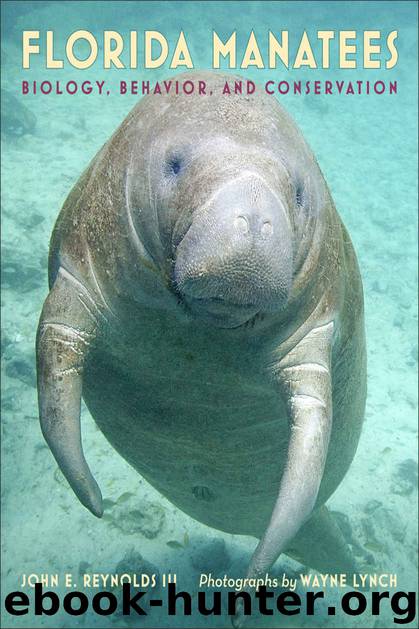Florida Manatees: Biology, Behavior, and Conservation by John E. Reynolds III

Author:John E. Reynolds III
Language: eng
Format: azw3
Publisher: Johns Hopkins University Press
Published: 2017-05-14T04:00:00+00:00
Florida manatees, such as this visitor to a warm-water refuge, have rather rough skin, which facilitates the attachment and growth of organisms. Dugongs and Amazonian manatees have much smoother skin, similar to that of dolphins.
On the other hand, manatees may die quickly from exposure to intense cold, in which case a diagnosis as to the cause of death may be extremely difficult. In humans, uncoordinated contractions of the heart muscle (myocardial fibrillation) can cause death in individuals whose body temperature drops below 82°F (~28°C). Also, diseases such as pneumonia or bronchitis may occur in cold-stressed manatees, as they do in humans.
A confounding variable when dealing with the effects of cold on manatees involves individual variations among these animals. Just as some people are better able to withstand cold weather due to their body’s insulation, proportions (the surface-area-to-volume ratio), resting metabolic rate, health status (including that of their circulatory system), nutritional status, or other variables, the same appears to hold true for manatees. Some manatees seek warm water in October, at the first sign of cold, whereas others may rarely, if ever, visit a warm-water refuge.
Download
This site does not store any files on its server. We only index and link to content provided by other sites. Please contact the content providers to delete copyright contents if any and email us, we'll remove relevant links or contents immediately.
The Lonely City by Olivia Laing(4569)
Animal Frequency by Melissa Alvarez(4150)
All Creatures Great and Small by James Herriot(3986)
Walking by Henry David Thoreau(3681)
Exit West by Mohsin Hamid(3634)
Origin Story: A Big History of Everything by David Christian(3472)
COSMOS by Carl Sagan(3348)
How to Read Water: Clues and Patterns from Puddles to the Sea (Natural Navigation) by Tristan Gooley(3240)
Hedgerow by John Wright(3106)
How to Do Nothing by Jenny Odell(3102)
The Inner Life of Animals by Peter Wohlleben(3099)
How to Read Nature by Tristan Gooley(3079)
Project Animal Farm: An Accidental Journey into the Secret World of Farming and the Truth About Our Food by Sonia Faruqi(3018)
Origin Story by David Christian(2992)
Water by Ian Miller(2953)
A Forest Journey by John Perlin(2916)
The Plant Messiah by Carlos Magdalena(2747)
A Wilder Time by William E. Glassley(2690)
Forests: A Very Short Introduction by Jaboury Ghazoul(2671)
